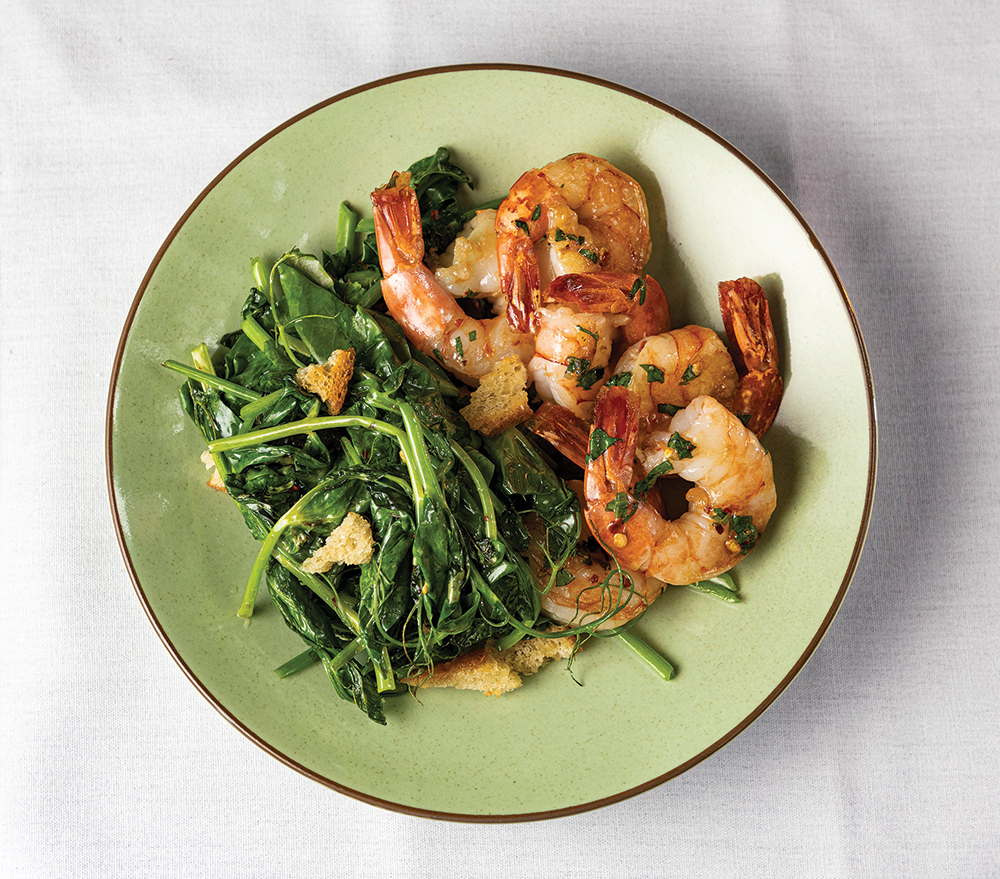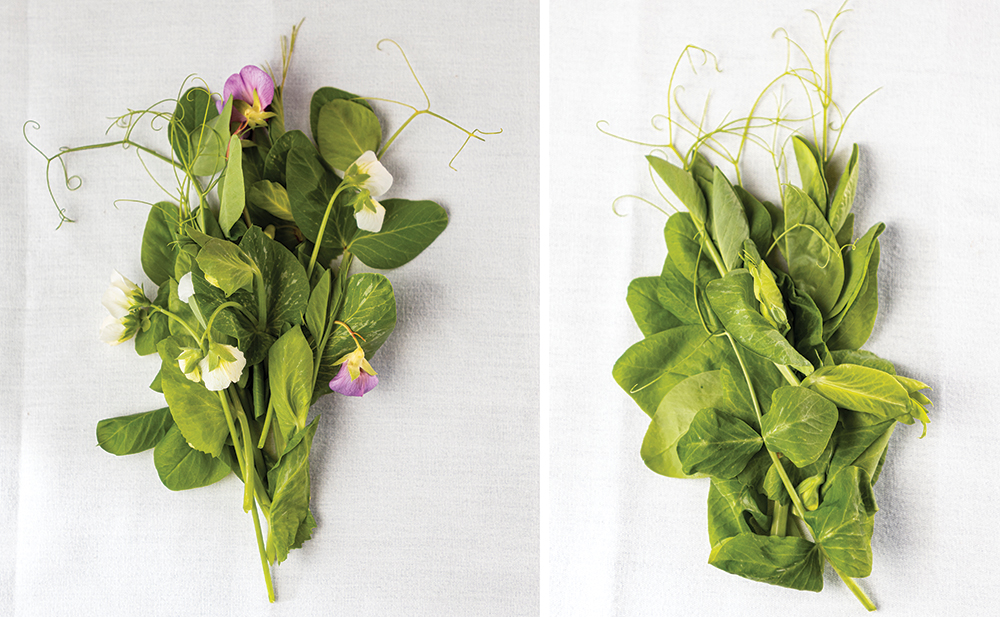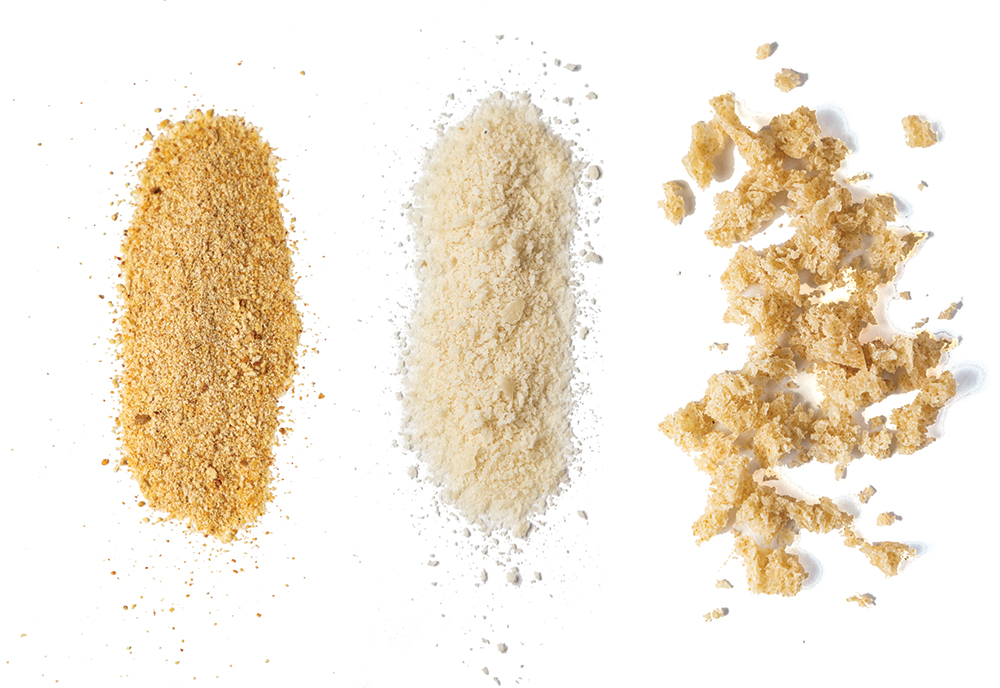
If you’ve ever grown your own peas, you might on occasion feel that the amount of food produced seems a bit underwhelming considering the amount of work that went into planting, growing, harvesting, possibly preserving, and preparing a little bowl of peas. Well, it’s quite possible that you’ve been overlooking a delicious part of the plant and the harvest—the tendrils.
Before we go any further, we need to make sure we’re talking about the same peas—pea nomenclature can be a bit confusing, and meanings can vary regionally and culturally. First, there are garden peas (AKA English peas, the little round pebble-shaped ones you usually see used as a fresh or frozen vegetable) that have to be removed from the shell/pod to be eaten. Second there are the edible podded peas (AKA sugar snap and snow peas—snap/sugar snap have thick-rounded pods, snow peas have thin, flat pods). Edible pod peas are eaten when very young, and are also referred to as Mangetout peas, French for “you eat the whole thing.” Lastly we have field peas (think split pea) grown for drying, treated as a grain. The thing they all have in common is their tasty little tendrils.
When it comes to pea tendrils, culinarily speaking, we’re not talking about the botanically designated clinging tendrils (the little string-like part of a plant that attaches to other things to support the plant). What we’re referring to is the tender, leafy tips of the pea vines—which include the little threads that support the plants—approximately the four to eight inches at the growing end of the vine. For human consumption, you are looking for the part of the stem that is still tender, meaning the part that has not yet become too sturdy and woody. You can actually feel between your fingers when the stems are no longer tendrils and instead are just tough “vine.” If you’re picking your own, avoid the stems that feel almost like straw or a twig—it will be too tough to chew. Avoid those with flowers because the flowers will eventually produce the delicious pods and peas.
The flavor of tendrils is fresh and light, milder than spinach, a bit nutty, grassy, and “green.” If you don’t grow your own, they are often available in Asian markets in the produce section, or in early spring at the farmer’s market. Tendrils aren’t limited to peas. The tender ends of the vines of zucchini, sweet potatoes, and cucumber are all tasty and edible in the same way. If the vines seem “hairy,” don’t worry.The tiny spines soften when cooked. The earliest (and spine-free) tendrils can be eaten raw in salads, dressed simply with a vinaigrette, perhaps mixed with other tender spring salad greens. They can also be treated like spinach, steamed or wilted, sautéed, or simmered in soup. I love them briefly sautéed to accompany just about anything.
For the thrifty cook—and what good cook isn’t thrifty, especially in the time of our pandemic—it also means using parts of the plant that might otherwise go to waste. This spring, expand your repertoire. Explore cooking with tendrils and try my simple technique with garlic and crushed red pepper.
Sautéed Pea Tendrils
Collect a big bunch of tender tendrils from the garden or market. In either case, they will need to be thoroughly rinsed. Remember, they collapse like spinach when cooked, so start with more than you think you will possibly need. Drain but don’t dry the greens. Heat a large skillet and add a generous glug of extra-virgin olive oil or other cooking fat. Have a cover ready for the skillet. Crush or slice a clove or two of fresh garlic and add to the oil, followed by a sprinkling of red pepper flakes, amounts of both related to your preferences for garlic and spicy heat. Just remember that the flavor of tendrils can be delicate. When the garlic begins to color golden around the edges, add the greens all at once, and cover. There will be considerable popping and splattering of oil, so be prepared. Shake the skillet a little, and after a minute or two when the sputtering subsides, uncover the tendrils and stir. Season with salt (or maybe soy sauce or coconut aminos), and cover again for another minute or three until the greens are just barely wilted. Uncover and taste for seasoning and correct as needed. For a more filling variation, you could toss the greens with cooked potato, sweet potato, spiralized zucchini, or rice. Or, since we’re being thrifty, a little crunchy toasted stale bread added right at the finish adds texture and substance. Serve tendrils as a brilliant and fresh green side dish—they’re especially lovely with seared, grilled, or poached shrimp or chicken. Enjoy.
In Your Pantry: Bread Crumbs
Bread crumbs are incredibly versatile and they come in a number of shapes, sizes, and flavors. Choose the “plain” or unseasoned ones when purchasing. That will give you more leeway when cooking.
Fine: Plain fine bread crumbs are for more than just coating a pork chop to fry or binding a loose meatball. They are an excellent thickener for sauces—bread crumbs are already cooked, so they don’t taste like raw flour or starch. They don’t form lumps and with just a few minutes of cooking will lend a velvety quality to a watery sauce. Lightly toasted in butter with a little cinnamon and sugar, they can add crunch to the layers in a strudel or provide an impromptu crust for a cheesecake.
Panko: The French word for bread (pan) plus the diminutive in Japanese (ko) equals a great ingredient for topping baked fish or mac and cheese, and for breading just about anything you can dream of deep frying. Their larger size lends more crunch than fine bread crumbs. Take them up a notch by tossing them with dried oregano, parsley, pepper flakes or lemon zest and a drizzle of oil. The seasoning depends on you.
Hand Made: All of that bread you’re baking in quarantine—don’t let even a slice of it go to waste. Stale bread gets a second life when turned into bread crumbs, and hand-torn bread crumbs are the luxe of luxe crumbs. To make your own fine bread crumbs, toast chunks or slices, then pulverize in a food processor. Your artisan bread torn into panko size or even larger bits, then lightly toasted yields optimum crunch. As a bonus, you can tear them while binging on Netflix and still feel like you’re accomplishing something. Some find it therapeutic.



